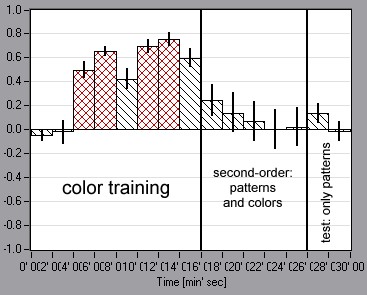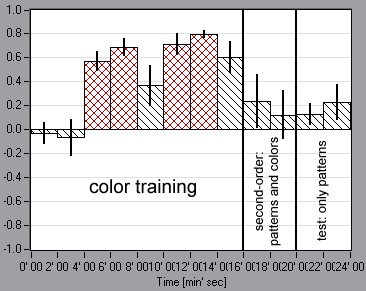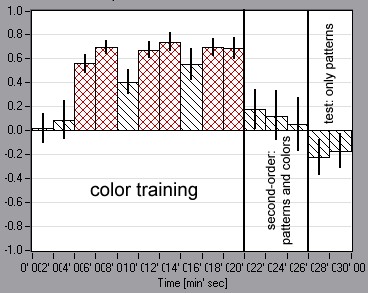|
The process of second-order conditioning is, in some ways, a reversal of the sensory-preconditioning procedure (see the features of classical conditioning). While in the latter the training of one of the stimuli follows the compound presentation, in the former the training precedes the compound presentation. One can conceptualize second-order conditioning as a transfer of the response eliciting properties of the US to a CS, strong enough to render the CS an efficient second-order US on its own. Since sensory preconditioning works in Drosophila, we would strongly suspect second-order conditioning to work as well. If that were so, one could explain the failed blocking experiment with the colors functioning as a second-order US, thereby accruing associative strength to the patterns and thus no blocking effect.  However, using three different combinations of longer and shorter first- and second-order training, we were not able to obtain a significant learning score for the second CS. In the first experiment (see the figure above) we tried to use the original timing from the blocking experiment, save the heat reinforcement. The final test scores failed to reach significant levels.  In the second experiment we reduced the amount of second-order training in order not to extinguish the second-order US. This did not produce significant learning scores in the final test, either.  In the third experiment we tried to increase the second-order reinforcing effect of the colors by extending the color training to 3x4 minutes and keeping the second-order training phase relatively short. This did not have the expected effect on the subsequent learning scores, either. Thus, we stand puzzled by the fact that Drosophila fails in blocking, performs well in sensory preconditioning and nevertheless second-order conditioning could not be found. A detailed discussion of these results s available in our paper "Conditioning with compound stimuli in Drosophila at the flight simulator" (PDF). |